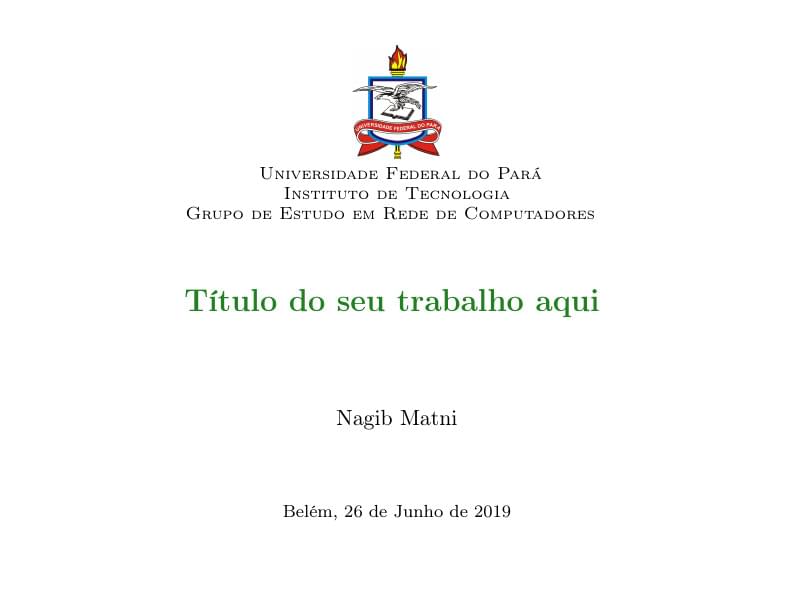
template criado para a apresentação do laboratorio
Based on the Feather Beamer Theme.

% Versao 1.0 - Helder Oliveira
% Versao 1.1 - Joahannes Costa
% Versao 1.1.1 - Nagib Matni
% Widescreen
%\documentclass[10pt,aspectratio=169]{beamer}
% 4:3
\documentclass[10pt]{beamer}
%Exibir notas na segunda tela
% \usepackage{pgfpages}
% \setbeameroption{show notes on second screen}
%OBS: se a barra de progresso quebrar, mexer na
% parte "calculate end position" do arquivo beamerouterthemeLRC.sty
% e somar o número no 360 para corrigir.
\makeatletter
\def\beamer@calltheme#1#2#3{%
\def\beamer@themelist{#2}
\@for\beamer@themename:=\beamer@themelist\do
{\usepackage[{#1}]{\beamer@themelocation/#3\beamer@themename}}}
\def\usefolder#1{
\def\beamer@themelocation{#1}
}
\def\beamer@themelocation{}
\usefolder{LRCgraphics}
\usetheme{LRC}
\definecolor{LRCcolorgreen}{RGB}{34,128,34}
\definecolor{LRCcolorgrey}{RGB}{193,193,193}
\setbeamercolor{LRC}{fg=LRCcolorgrey,bg=LRCcolorgreen}
\setbeamercolor{block title}{bg=LRCcolorgreen,fg=white}
\setbeamercolor{structure}{fg=black}
\setbeamercolor{normal text}{fg=black,bg=gray!10}
\setbeamertemplate{section in toc}{%
{\color{LRCcolorgreen}\inserttocsectionnumber.}~\inserttocsection}
\setbeamercolor{subsection in toc}{bg=white,fg=structure}
\setbeamertemplate{subsection in toc}{%
\hspace{1.2em}{\color{LRCcolorgreen}\rule[0.3ex]{3pt}{3pt}}~\inserttocsubsection\par}
\mode<presentation>
{
\setbeamertemplate{enumerate items}[circle]
\setbeamertemplate{itemize item}[square]
\setbeamertemplate{itemize subitem}[circle]
\setbeamertemplate{itemize subsubitem}[triangle]
\setbeamercolor{item projected}{bg=LRCcolorgreen}
\setbeamercolor{itemize item}{fg=LRCcolorgreen}
\setbeamercolor{itemize subitem}{fg=LRCcolorgreen}
\setbeamercolor{itemize subsubitem}{fg=LRCcolorgreen}
}
%-------------------------------------------------------
% INCLUDE PACKAGES
%-------------------------------------------------------
\usepackage[utf8]{inputenc}
\usepackage[portuguese]{babel}
\usepackage[T1]{fontenc}
\usepackage{helvet}
\usepackage{graphicx,subfigure}
%-------------------------------------------------------
% DEFFINING AND REDEFINING COMMANDS
%-------------------------------------------------------
% colored hyperlinks
\newcommand{\chref}[2]{
\href{#1}{{\usebeamercolor[bg]{\theme\LRC}#2}}
}
%-------------------------------------------------------
% INFORMATION IN THE TITLE PAGE
%-------------------------------------------------------
\title[Understanding the Limits of LoRaWAN]
{
\textcolor{LRCcolorgreen}{\textbf{Título do seu trabalho aqui}}
}
\subtitle[~]
{
%\textbf{Subtítulo do seu trabalho aqui, comente se não tiver}
}
\author[Nagib Matni]
{Nagib Matni}
\institute[]
{
% \includegraphics[scale=0.3]{LRCgraphics/logo-unicamp.eps}\\
\includegraphics[scale=0.3]{LRCgraphics/ufpa.eps}\\
\textsc{
Universidade Federal do Pará\\
Instituto de Tecnologia\\\vspace{-0.1cm}
Grupo de Estudo em Rede de Computadores
}
}
\date{Belém, \today}
%-------------------------------------------------------
% THE BODY OF THE PRESENTATION
%-------------------------------------------------------
\begin{document}
%-CAPA
{\1
\begin{frame}[plain,noframenumbering]
\titlepage
\end{frame}
}
%-AGENDA
\begin{frame}{Agenda}{}
\tableofcontents
\end{frame}
%Aparece menu a cada nova seção
\AtBeginSection[]
{
\begin{frame}<beamer>
\frametitle{Agenda}
\tableofcontents[currentsection]
\end{frame}
}
%-INICIO
\section{Introdução}
%-
\subsection{Histórico}
\begin{frame}{Introdução}{Histórico}
\begin{itemize}
\item \textbf{1G}: Sistemas analógicos. Nenhum tipo de transmissão de pacotes de dados.
\item \textbf{2G}: Sistemas digitais. Mensagens SMS, email, dentre outros. Taxas de transmissão de 9,6 kbps.
\item \textbf{3G}: Sistemas celulares com serviços de dados por pacotes e taxas maiores que 256 kbps.
\item \textbf{4G}: Sistemas projetados para oferecer taxas de download de 100Mbps com o usuário em movimento e 1Gbps com usuário parado. O uplink é de até 500Mbps.
\item \textbf{5G}: Novas aplicações.
\end{itemize}
\begin{figure}[!htb]
\centering
\includegraphics[scale=0.4]{images/5G-Evolution-Chart.png}
\caption{Geração das redes móveis \cite{ciena5g2018}}
\end{figure}
\end{frame}
%-
\begin{frame}{LTE cont.}{Comutação}
\begin{table}[]
\begin{tabular}{l|l|l}
\hline
\textbf{Item} & \textbf{Circuitos} & \textbf{Pacotes} \\ \hline
Configuração de chamadas & Obrigatória & Não necessária \\ \hline
Caminho físico dedicado & Sim & Não \\ \hline
Pacotes seguem o mesmo caminho & Sim & Não \\ \hline
Pacotes chegam na mesma ordem & Sim & Não \\ \hline
Reserva da largura de banda & Fixa & Dinâmica \\ \hline
Largura de banda desperdiçada & Sim & Não \\ \hline
A falha de um equipamento é fatal & Sim & Não \\ \hline
\end{tabular}
\caption{Comparação entre comutações de circuitos e pacotes\footnote{\url{http://www.teleco.com.br/tutoriais/tutorialvoipconv}}}
\end{table}
\end{frame}
%-
\begin{frame}{LTE}{Características}
\begin{table}[]
\begin{tabular}{l|l|l|l}
%\hline
Tecnologia & Downlink\footnote{ERB $\rightarrow$ Celular} & Uplink\footnote{Celular $\rightarrow$ ERB} & Canalização (MHz) \\ \hline
LTE & 100 Mbps & 50 Mbps & 20 \\ \hline
LTE-A & 1.0 Gbps & 0.5 Gbps & 100 \\ \hline
LTE-A Pro & 3.0 Gbps & 1.5 Gbps & 640 \\
%\hline
\end{tabular}
\caption{Principais características das redes LTE}
\end{table}
\end{frame}
%-
\section{Características}
\begin{frame}{LTE}{Características}
\begin{itemize}
\item Altas taxas de dados.
\item Baixa latência.
\item Comunicação de voz por IP, denominado VoIP.
\item Utiliza OFDMA (Orthogonal Frequency Division Multiple Access) para Downlink.
\item Utiliza SC-FDMA (Single Carrier - Frequency Division Multiple Access) para o Uplink.
\end{itemize}
\end{frame}
%-
\begin{frame}{LTE}{Características}
\begin{itemize}
\item Altas taxas de dados.
\item Baixa latência.
\item Comunicação de voz por IP, denominado VoIP.
\item Utiliza OFDMA (Orthogonal Frequency Division Multiple Access) para Downlink.
\item Utiliza SC-FDMA (Single Carrier - Frequency Division Multiple Access) para o Uplink.
\item Tecnologia de antena MIMO (Multiple Input Multiple Output).
\item Infraestrutura simplificada, com dois tipos de nós: Estação Base e Gateways.
\end{itemize}
\end{frame}
%-
\section{Seção 3}
\begin{frame}{LTE}{Arquitetura}
\begin{figure}[!ht]
\centering
\subfigure[Com contenção]{
\includegraphics[scale=0.3]{images/contencao-based.png}
}
\subfigure[Sem contenção]{
\includegraphics[scale=0.3]{images/contencao-free.png}
}
\label{fig:redecomplexa}
\end{figure}
\end{frame}
%- REFERENCIAS
\begin{frame}[allowframebreaks]{Referências}
\small{
\bibliography{referencias}
}
\bibliographystyle{IEEEtran}
\end{frame}
%- FINAL
{\1
\begin{frame}[plain,noframenumbering]
\finalpage{\large{
\textbf{Obrigado!} \\
\vspace{0.2cm}
\url{www.lrc.ic.unicamp.br/~seuusuario}
}}
\end{frame}
}
\end{document}